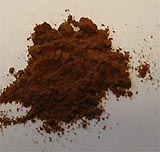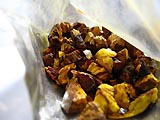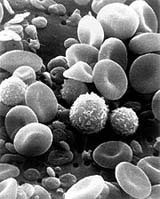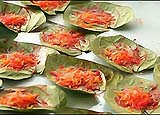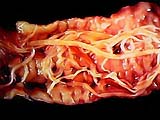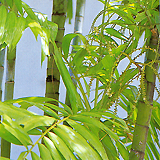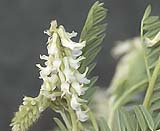Supari or betel nut (Areca catechu, Linn.)
The betel nut is a nut that is chewed as a mild stimulant. It is probably used much more frequently than other masticatory agents including tobacco, chewing gum and cola.
This very ancient practice was indulged in by all classes of people throughout history.
The habit is prevalent from the Reunion islands and Zanzibar to India, Burma, Malaysia, Vietnam, South eastern China, Indonesia, the Philippines and islands of the Pacific Ocean. The ancient Greek historian Herodotus described the habit as far back as 340 B.C. itself. Chewing betel is so widespread in India that over 100,000 tons of nuts are used in India alone. It is usually chewed after meals or more commonly along with betel leaf or pan, with or without tobacco, and some-times with a variety of many other ingredients that are prepared in rather elaborate ways. Its chewing has become a ceremonial necessity in this country. It forms an auspicious material for greeting elders, guests and gods.
Betel or areca nut (probably named after its name in Kannada, viz., adake) are the seeds of the betel palm, Areca catechu. They belong to the same family as the coconut i.e. Palmae. Chamber’s English Dictionary traces the root of the term Areca to a Portuguese adaptation of the Malaysian word, adekka, for the plant.
The term catechu refers to a dark extract of some Indian plants such as acacia. In Malay, this is called cachu while in India, it is more known as cathaa, though the term kachu is also found in North Karnataka.
The plant is native of Malaysia especially the Sunda Islands, but it is extensively cultivated wherever the nuts are used, for instance, in India and the eastern Archipelago. Betel chewing is often a complex art. The simplest and the most common method is to take a mixture of three ingredients, betel leaf, betel nut and lime. Slices of cured or semi ripe or fully ripe nuts are placed in the mouth with fresh leaves of betel smeared with lime. It gives a fine fragrance to the breath, but stains and destroys teeth and gums. It however aids digestion. Quite often an elaborate mixture of cloves, cinnamon, cardamom, nutmeg and other spices are added along with the betel leaf. Another method is to use tobacco. The use of betel is however habit inducing.
Names
Sanskrit offers a long list of names to this auspicious plant. They are: akota, chataphata, chikkana, dirgha padapa (an elongated tree), dridha valkala (with a firm bark), ghonta, gopadala, guvaka, kapitana, khapura, kra-muka, puga, pugi, raja tala (the royal tala), suranjana, tambula, tantu sara (fibrous fruit) and valkataru.
This is called buah or puah in Assam; qua, supari in Bengali; supari in Hindi; adake, puga, kaungu in Kannada; atekka, ghonta, kamuka in Malyalam; kamugu, pakku, pugam in Tamil; chikinamu, gautopoka, kolapoka, kramukamu in Telugu and supari in Urdu.
Apart from betel and areca nut the two most common terms, the English also call it by many other interesting names. They are: catechu palm, catechu tree, drunken tree, date tree, fasel nut, medicinal cabbage tree, penang palm and supari palm.
Most European languages use the word, areca, as the base and call this plant accordingly. Thus, the tree in French is arec, arec de l’Inde; in German, areca palme; betel palma in Russian, and in Swedish it is known as areka.
Botanical aspects
The genus Areca has two species in India: A. catechu Linn., the areca nut which is well known and A. nagensis Griff. of the Naga Hills, which is not so well known, being restricted to the Eastern Himalayas. The latter has a lesser height of 9 – 12 meters. The trunk is attached to the soil by innumerable black fibrous roots. The fruit is somewhat similar to that of areca. Nagas actually use this material as a substitute to it. They call it talpat.
There are two more plants whose fruits are used as a poor substitute for betel nut by the local population. They are: Penanga dicksoni, found in the mountains of Kerala and Western Karnataka. This is called kanakamukha (gold faced) in Malyalam, konda (the hill betel nut) in Telugu and kadu adike (forest or wild betel nut) or jandarige in Kannada. The other plant is Loxodoccus rupicola Windl. This is almost restricted to Sri Lanka, where it is called dotaly. The plant areca catechu has a characteristic, tall, unbranched, slender and perfectly erect stem, rising to a height of 12 – 30 metres, usually about 50 centimeters in circumference and uniformly thick. A plantation of areca nut gives the distinctive appearance of straight pillar like trees. These graceful pillars hold a crown of elegant leaves. They are also large and much like those of the coconut palm, huge and pinnate, with leaflets arranged on either side of a large central rachis, like the feathers of a bird. The leaflets are numerous, 30 – 60 centimeters long, the upper ones being united and all smooth, hairless, shiny and richly green. The spathe or large bract of the inflorescence is double in nature and is compressed, smooth and bald.
The spadix or fleshy inflorescence bears male and female flowers together, both stalkless and much branched. The male flowers are numerous while the female ones are solitary and situated at or near the base of each branching spadix. The fruit is 3 – 8.5 centimeters long, smooth, green when young, becoming orange or scarlet at maturity. It is a drupe with the wall differentiating into three distinct regions. The regions are: the outer thin epicarp, the middle fibrous mesocarp and the inner stony endocarp.
Inside the fruit, there is a single seed which bears an endosperm that is stony hard at maturity and deeply ruminate in structure, i.e. it appears as if it is deeply but irregularly cut. It is this endosperm that is exposed, cured, dried in the sun and used as the supari or betel nut. The seed is hard, heavy and bluntly conical. Areca nut plantations are an exacting agricultural exercise. They require constant care, but this is highly remunerative as the nuts are always costly and in great demand here and abroad. There are many cultivated varieties of the areca nut such as jahaju which is a long nut, manak chandi (shaped as a sphere), Shrivardhini (a place near Ratnagiri in Maharashtra) and so on. The first two are most common.
Constituents
The part most used is the kernel or endosperm of the seed or its extract. The root and tender leaves are also employed medicinally. A black coloured extract called catechu is prepared from the seeds and used in various ways. In fact, it is the watery extract of the betel kernel that yields the commercial catechu.
The kernel contains catechu, tannin, gallic acid, oily matter (with 14 per cent fat), gum and characteristic alkaloids (which act as stimulants) such as arecaidine, guvacoline, guvacine and choline. The last two appear only in traces. All of these alkaloids are also related to one another chemically. Arecoline is a colourless volatile material much resembling nicotine, the unique alkaloid in tobacco. Of all the alkaloids, it is the arecoline that is the most important. It is also an anthelminthic.
Pharmacology or drug action
Fresh, uncured betel nuts are intoxicating, producing giddiness in some people. But the dried and cured nut, in which form it is mostly used, is a stimulant, astringent and febrifuge i.e. remover of fever. Chewing the nut increases the formation of saliva. It decreases perspiration, sweetens the breath, strengthens the gums and generates a mild exhilaration giving the feeling of a good disposition. Since arecoline is readily absorbed into the body, it is not advisable to use it in a pure condition for destroying tape worms for which purpose it is often recommended. Instead, it is better to use the powdered nut.
Pharmacologically the action of arecoline very much resembles that of muscarine, palleterine and pilocarpine all of which are violent stimulants of the parasympathetic nervous system. They stimulate the intestines, constrict the bronchi decrease the heart rate and lower blood pressure.
Arecoline also stimulates salivation and decreases sweating. The nut is used medicinally in various forms, as powders (in dosage of 10 – 30 grams), fluid extracts (doses of 10 to 30 minims) and tinctures (1 to 2 drachms). Arecoline hydrobromide is a statutory drug in the Indian, British, German and French pharmacopias. Taenine is a preparation containing areca nut extract, forming a liquid medicine used in veterinary practices against tape worms. The advised dosage of this medicine for a dog is one minim for every pound of body weight.
Modern work
Recent studies have concentrated on polyphenol, an important constituent of the areca nut. The effect of this element when isolated from fresh and unripe nuts was studied on the uterus of rats under various hormones. The ethyl acetate fraction of the aqueous extract was stimulant to a low degree on all the uteri but its spasmogenic activity was comparatively more on the uteri treated with progesterone.
The alcoholic extract of the nuts exerted distinct oxytocic action on an isolated rat uterus in a dose of 100mg. The petroleum ether and aqueous extracts of the nuts were found to provide encouraging antifertility activity in rats.
Extracts of areca nuts taken in water, alcohol, alkali and acid have been shown to have a constrictive effect on capillaries to a varying degree when tested by a technique known as rat hind limb perfusion. The alkaline extract was found to be most potent in intensity and duration.
Arecoline, the characteristic alkaloid from the nuts, when given in a dose of 1 mg per kilogram body weight to rats intraperitoneally, induced slight sedation after five minutes. After 30 minutes however, the rats regained their activity but took more time to reach their goal. They also showed a loss of appetite. This indicates that the alkaloid has a depressing action on the central nervous system.
Another important discovery is that aqueous extracts of the betel nut have been shown to have an inhibiting action on the growth of Staphylococcus aureus and Trichophyton rubrum. The effect was seen in vitro.
The alcoholic extracts of the betel nut are shown to have a similar effect on the growth of some other micro-organisms, such as Escherichia coli (causing diarrhoea), Candida albicans and C. tropicalis (causing skin disease) and Trichophyton interdigitale (causing a skin affliction between the fingers).
The action of the extract of areca nuts was also tested on the white blood corpuscles in vitro. It was seen that this depressed the normal phagocytic effect of the white blood corpuscles.
Medicinal uses
Apart from its value when chewed, the nut has considerable uses in medicine too. Paan chewing with betel nut is popularly believed to prevent tooth decay.
But with regular practice, a constant irritation in the mucous membranes of the mouth and gums results, bringing inflammation, a loosening or loss of teeth and sometimes even cancer.
Ayurveda regards it as heavy for digestion, cooling, dry and astringent in taste. It destroys pitta and kapha, is intoxicating, a stimulant and laxative. The raw and the unripe nut is poisonous and harmful to the eyesight. The cured hard centre is excellent for destroying all three doshas. In general it can be said that the betel nut is like poison when young, purgative in the middle stage, but an elixir when fully ripe and dry. The nut should therefore be taken only in the third stage.
According to Yunani physicians betel nut is considered digestive, contractive and diuretic, strengthening the heart and regulating menstrual flow. It is used for overcoming swollen eyes, mental confusion, chronic urinary distress and pus formation. It is also a nerve tonic and an aphrodisiac.
A gum-like exudation occurs on the bark of the fully grown trees. This is heavy, cooling, intoxicating, bitter and acrid. It causes pitta but destroys vata dosha.
1. Gastrointestinal problems
i) Powdered nuts are given in a dosage of 5 rattis to one masha in cases of diarrhoea caused by debility at an interval of 3 to 4 hours. Such a procedure also proves beneficial for disorders in urination.
ii) Areca nut burnt to charcoal with catechu and 1/4rth of its quantity of cinnamon makes a good tooth powder.
iii) The unripe nut is rubbed with milk and drunk to destroy tape worms.
iv) A pinch of its powder mixed with turmeric powder and sugar will stop vomiting.
v) The tendency of skin peeling off at the mouth is stopped by sprinkling the ashes of betel nut with cardamom.
vi) An excellent vermifuge can be prepared by rubbing approximately 4mg of betel nut powder in 20ml of fresh lemon juice. It is administered in a dose of one teaspoonful, after fasting for 12 to 14 hours, with ghee or more preferably, floating on milk.
A positive action is noticed within an hour of administration for both round and tape worms. This is also employed for colicky pains in horses and men. In large doses (say 6 drachms to one ounce) however, it causes gripping (painful contractions), irritation and loose motions.
vii) 1 drachm of the tincture of areca in 4 ounces of water is used as a gargle against bleeding gums.
2. Eyes
i) A lotion from it is sometimes used to constrict the pupils like atropine.
ii) Nuts are burnt, powdered fine and used as collyrium to prevent discharges and inflammations of the eyes.
3. Muscle relaxant
An extract from tender young leaves is made for massaging the muscles and tendons of the waist, in case of aches and pains there.
4. Urinary disorders
i) A decoction of betel nut and khair (khadira) taken with honey cures minor urinary affections.
ii) A sprinkling of betel nut powder cures syphilitic ulcers.
5. Lumbago
The juice of tender leaves is mixed with a bland oil and applied as lotion) in cases of lumbago.
6. Ulcers
In Sri Lanka, the nut is scraped and applied externally to heal ulcers.
7. Poison
In Malaysia, the green fruit is employed as a poison in combination with opium.8. Abortion
The young green shoots are used to bring about abortion in early pregnancy.
Side effects
i) Two harmful effects of areca are: it causes roughness in the chest and urinary stones. Katira (exudation from the tree of the Astragalus strobilifera) and cardamon can effectively counteract these ill effects.
ii) Excessive use of supari leads to anaemia and the appearance of jaundice.
Bibliography
1. A.V.S.S. Samba Murthy and N.S. Subramaniam. A Text Book of Economic Botany. New Delhi: Wiley Eastern Limited, 1989. pages 482-483, 698,700.
2. K.M. Matthew. An Excursion Flora of Central Tamil Nadu. New Delhi, India; Oxford & IBH Publishing Co. Pvt. Ltd., 1991, p. 189.
3. K.M. Nadkarni. Indian Materia Medica, Vol. I. Mumbai Popular Prakashan Private Ltd., 1982.
4. K.R. Kirtikar and B.D. Basu. Indian Medicinal Plants, Vol II. Dehradun; International Book Distribution, 1988.
5. Naveen Patnaik. The Garden of Life. New Delhi: Harper Collins Publishers, 1993.
6. N.K. Shanmugam. Mooligai Kalai Kalangium. Chennai; Kalaiselvi Publications, 1997.
7. P.K. Warrier, V.P. Nambiar, C. Ramankutty. Indian Medicinal Plants. Chennai; Orient Longman Limited, 1996.
8. S. Kannusamy Pillai. Siddha Vaidya Pathartha Guna Vilakkam (Moola Vargam). Chennai; B. Rathina Naikar & Sons, 1990.
9. The Wealth of India. New Delhi; Publications and Information Directorate, CSIR, 1976, [Vol.X]: 171-77.
10. The Useful Plants of India. New Delhi; Publications & Informations Directorate, CSIR, 1986.
Dr. K.H. Krishnamurthy has written about medicinal plants as used in the Indian context with deep interest. He is a botanist by profession and poet by sentiment.
Share with us (Comments, contributions, opinions)
When reproducing this feature, please credit NAMAH, and give the byline. Please send us cuttings.




